CO2 Emission from Caves by Temperature-Driven Air Circulation—Insights from Samograd Cave, Croatia
Abstract
1. Introduction
2. Materials and Methods
2.1. Cave Description
2.2. Methods
3. Results
3.1. Air Temperature
3.2. Carbon Dioxide
4. Discussion
4.1. Cave Climate
4.2. Temporal Variability of pCO2 Values
4.3. Spatial Distribution of pCO2 Values
5. Conclusions
Author Contributions
Funding
Data Availability Statement
Acknowledgments
Conflicts of Interest
References
- Friedlingstein, P.; O’Sullivan, M.; Jones, M.W.; Andrew, R.M.; Bakker, D.C.E.; Hauck, J.; Landschützer, P.; Le Quéré, C.; Luijkx, I.T.; Peters, G.P.; et al. Global carbon budget 2023. Earth Syst. Sci. Data 2023, 15, 5301–5369. [Google Scholar] [CrossRef]
- Lan, X.; Tans, P.; Thoning, K.W. Trends in Globally-Averaged CO2 Determined from NOAA Global Monitoring Laboratory Measurements, version 2024-08; Global Monitoring Laboratory: Boulder, CO, USA, 2024. [Google Scholar] [CrossRef]
- Archer, D.; Eby, M.; Brovkin, V.; Ridgwell, A.; Cao, L.; Mikolajewicz, U.; Caldeira, K.; Matsumoto, K.; Munhoven, G.; Montenegro, A.; et al. Atmospheric lifetime of fossil fuel carbon dioxide. Annu. Rev. Earth Planet. Sci. 2009, 37, 117–134. [Google Scholar] [CrossRef]
- Baldini, J.U.; Bertram, R.A.; Ridley, H.E. Ground air: A first approximation of the Earth’s second largest reservoir of carbon dioxide gas. Sci. Total Environ. 2018, 616–617, 1007–1013. [Google Scholar] [CrossRef] [PubMed]
- Atkinson, T.C. Carbon dioxide in the atmosphere of the unsaturated zone: An important control of groundwater hardness in limestones. J. Hydrol. 1977, 35, 111–123. [Google Scholar] [CrossRef]
- Kukuljan, L.; Gabrovšek, F.; Covington, M.D.; Johnston, V.E. CO2 dynamics and heterogeneity in a cave atmosphere: Role of ventilation patterns and airflow pathways. Theor. Appl. Climatol. 2021, 146, 91–109. [Google Scholar] [CrossRef]
- Covington, M.D. The importance of advection for CO2 dynamics in the karst critical zone: An approach from dimensional analysis. In Caves and Karst Across Time Special Paper 516; Feinberg, J.M., Gao, Y., Alexander, E.C., Jr., Eds.; Geological Society of America: Boulder, CO, USA, 2016. [Google Scholar] [CrossRef]
- Hendry, M.J.; Wassenaar, L.I. Origin and migration of dissolved organic carbon fractions in a clay-rich aquitard: 14C and δ13C evidence. Water Resour. Res. 2005, 41, W02021. [Google Scholar] [CrossRef]
- James, J.M. Carbon dioxide in the cave atmospshere. Trans. Brit. Cave Res. Assoc. 1977, 4, 417–429. [Google Scholar]
- Baldini, J.U.L. Cave atmosphere controls on stalagmite growth rate and paleoclimate records. In Tufas and Speleothems: Unravelling the Microbial and Physical Controls; Pedley, H.M., Rogerson, M., Eds.; Geological Society of London: London, UK, 2010; pp. 283–294. [Google Scholar]
- Mattey, D.P.; Atkinson, T.C.; Barker, J.A.; Fisher, R.; Latin, J.P.; Durrell, R.; Ainsworth, M. Carbon dioxide, ground air and carbon cycling in Gibraltar karst. Geochim. Cosmochim. Acta 2016, 184, 88–113. [Google Scholar] [CrossRef]
- Mattey, D.; Atkinson, T.C.; Hoffmann, D.L.; Boyd, M.; Ainsworth, M.; Durell, R.; Latin, J.P. External controls on CO2 in Gibraltar cave air and ground air: Implications for interpretation of δ13C in speleothems. Sci. Total Environ. 2021, 777, 146096. [Google Scholar] [CrossRef]
- Milanolo, S.; Gabrovšek, F. Estimation of carbon dioxide flux degassing from percolating waters in a karst cave: Case study from Bijambare cave, Bosnia and Herzegovina. Geochemistry 2015, 75, 465–474. [Google Scholar] [CrossRef]
- Fairchild, I.J.; Baker, A. Speleothem Science: From Process to Paste Environment; Wiley-Blackwell: Chichester, UK, 2012; p. 450. [Google Scholar]
- Riechelmann, S.; Breitenbach, S.F.M.; Schröder-Ritzrau, A.; Mangini, A.; Immenhauser, A. Ventilation and cave air PCO2 in the Bunker-Emst cave system (NW Germany): Implications for speleothem proxy data. J. Cave Karst Stud. 2019, 81, 98–112. [Google Scholar] [CrossRef]
- Spotl, C.; Fairchild, I.J.; Tooth, A.F. Cave air control on dripwater geochemistry, Obir Caves (Austria): Implications for speleothem deposition in dynamically ventilated caves. Geochim. Cosmochim. Acta 2005, 69, 2451–2468. [Google Scholar] [CrossRef]
- Peyraube, N.; Lastennet, R.; Denis, A.; Malaurent, P. Estimation of epikarst air PCO2 using measurements of water δ13CTDIC, cave air PCO2 and δ13CCO2. Geochim. Cosmochim. Acta 2013, 118, 1–17. [Google Scholar] [CrossRef]
- Li, Y.; Yang, Y.; Wang, X.; Luo, W.; Zhao, J.; Sun, Z.; Ye, Z.; Chen, X.; Shi, X.; Xu, Y.; et al. Sources and transport of CO2 in the karst system of Jiguan Cave, Funiu Mountains, China. Sci. Total Environ. 2024, 918, 170507. [Google Scholar] [CrossRef] [PubMed]
- Badino, G. Underground meteorology—“What’s the weather underground”? Acta Carsologica 2010, 39, 427–448. [Google Scholar] [CrossRef]
- Gabrovšek, F. How do caves breathe: The airflow patterns in karst underground. PLoS ONE 2023, 18, e0283767. [Google Scholar] [CrossRef]
- Haszpra, L. Multi-decadal atmospheric carbon dioxide measurements in Hungary, central Europe. Atmos. Meas. Tech. 2024, 17, 4629–4647. [Google Scholar] [CrossRef]
- Faimon, J.; Ličbinská, M. Carbon dioxide in the soils and adjacent caves of the moravian karst. Acta Carsologica 2010, 39, 463–475. [Google Scholar] [CrossRef]
- Bourges, F.; Genty, D.; Perrier, F.; Lartiges, B.; Regnier, E.; Francois, A.; Leplat, J.; Touron, S.; Bousta, F.; Maasault, M.; et al. Hydrogeological control on carbon dioxide input into the atmosphere of the Chauvet-Pont d’Arc cave. Sci. Total Environ. 2020, 716, 136844. [Google Scholar] [CrossRef]
- Almagro, M.; Lopez, J.; Querejeta, J.I.; Martinez-Mena, M. Temperature dependence of soil CO2 efflux is strongly modulated by seasonal patterns of moisture availability in a Mediterranean ecosystem. Soil. Biol. Biochem. 2009, 41, 594–605. [Google Scholar] [CrossRef]
- Jin, M.S.; Mullens, T.A. Study of the Relations between soil moisture, soil temperatures and surface temperatures using ARM observations and offline CLM4 Simulations. Climate 2014, 2, 279–295. [Google Scholar] [CrossRef]
- Noormets, A. Phenology of Ecosystem Processes: Application in Global Change Research; Springer: Dordrecht, The Netherlands; Berlin/Heidelberg, Germany; London, UK; New York, NY, USA, 2009; p. 275. [Google Scholar] [CrossRef]
- Risk, D.; Kellman, L.; Beltrami, H. Carbon dioxide in soil profiles: Production and temperature dependence. Geophys. Res. Lett. 2002, 29, 1087. [Google Scholar] [CrossRef]
- Ford, D.; Williams, P.D. Karst Hydrogeology and Geomorphology; John Wiley & Sons: Chichester, UK, 2007; p. 562. [Google Scholar]
- Williams, P.W. The role of the epikarst in karst and cave hydrogeology: A review. Int. J. Speleol. 2008, 37, 4687. [Google Scholar] [CrossRef]
- Feher, R.; Bădăluță, C.-A.; Brad, T.; Drăgan, C.; Drăgușin, V.; Măntoiu, D.Ș.; Perșoiu, A.; Tîrlă, M.-L. Stable isotope hydrology of karst groundwaters in Romania. Water 2024, 16, 1489. [Google Scholar] [CrossRef]
- Lang, M.; Faimon, J.; Godissart, J.; Ek, C. Carbon dioxide seasonality in dynamically ventilated caves: The role of advective fluxes. Theor. Appl. Climatol. 2017, 129, 1355–1372. [Google Scholar] [CrossRef]
- Ek, C.; Godissart, J. Carbon dioxide in cave air and soil air in some karstic areas of Belgium. A prospective view. Geol. Belg. 2014, 17, 102–106. [Google Scholar]
- Šebela, S.; Prelovšek, M.; Turk, J. Impact of peak period visits on the Postojna Cave (Slovenia) microclimate. Theor. Appl. Climatol. 2013, 111, 51–64. [Google Scholar] [CrossRef]
- Baker, A.; Genty, D. Environmental pressures on conserving cave speleothems: Effects of changing surface land use and increased cave tourism. J. Environ. Manag. 1998, 12, 165–175. [Google Scholar] [CrossRef]
- Dragovich, D.; Grose, J. Impact of tourists on carbon dioxide levels at Jenolan Caves, Australia: An examination of microclimatic constraints on tourist cave management. Geoforum 2010, 21, 111–120. [Google Scholar] [CrossRef]
- Faimon, J.; Štelcl, J.; Sas, D. Anthropogenic CO2 flux into cave atmosphere and its environmental impact: A case study in the Císařská Cave (Moravian karst, Czech Republic). Sci. Total Environ. 2006, 369, 231–245. [Google Scholar] [CrossRef]
- Lang, M.; Faimon, J.; Ek, C. The relationship between carbon dioxide concentration and visitor, numbers in the homothermic zone of the Balcarka Cave (Moravian Karst) during a period of limited ventilation. Int. J. Speleol. 2015, 44, 167–176. [Google Scholar] [CrossRef]
- Perrier, F.; Le Mouel, J.L.; Kossobokov, V.; Crouzeix, C.; Morat, P.; Richon, P. Properties of turbulent air avalanches in a vertical pit. Eur. Phys. J. B 2005, 46, 563–579. [Google Scholar] [CrossRef]
- Perşoiu, A.; Onac, B.P.; Perşoiu, I. The interplay between air temperature and ice dynamics in Scărişoara Ice Cave, Romania. Acta Carsologica 2011, 40, 445–456. [Google Scholar] [CrossRef]
- McDermott, F.; Schwarcz, H.P.; Rowe, P.J. Isotopes in speleothems. In Isotopes in Palaeoenvironmental Research; Leng, M., Ed.; Springer: Dordrecht, The Netherlands, 2005; pp. 185–226. [Google Scholar]
- Kwiecien, O.; Braun, T.; Brunello, C.F.; Faulkner, P.; Hausmann, N.; Helle, G.; Hoggarth, J.A.; Ionita, M.; Jazwa, C.; Kelmelisj, S.; et al. What we talk about when we talk about seasonality—A transdisciplinary review. Earth-Sci. Rev. 2022, 225, 103843. [Google Scholar] [CrossRef]
- Baldini, J.U.L.; Baldini, L.M.; McDermott, F.; Clipson, N. Carbon dioxide sources, sinks, and spatial variability in shallow temperate zone caves: Evidence from Ballynamintra Cave, Ireland. J. Cave Karst Stud. 2006, 68, 4–11. [Google Scholar]
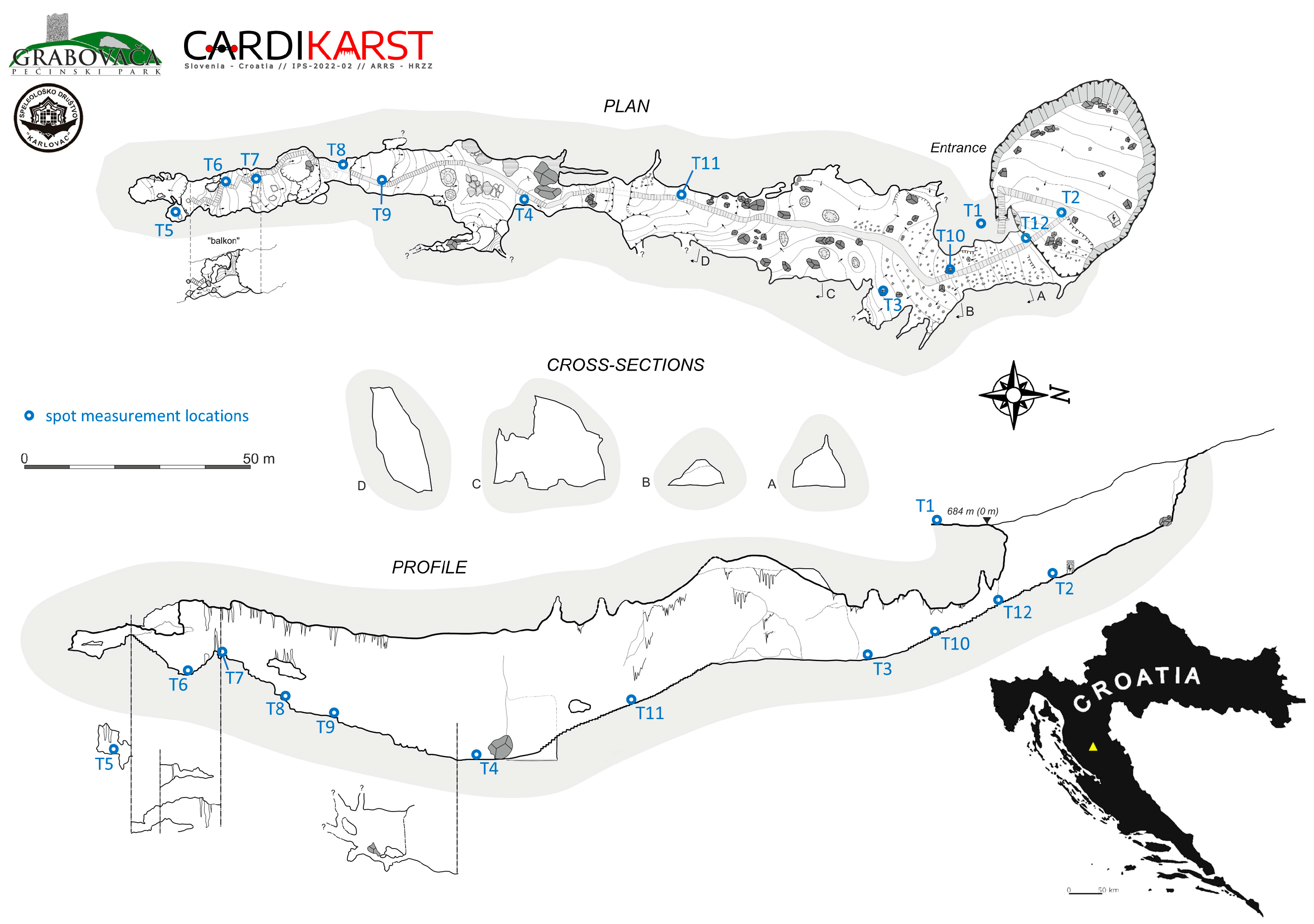

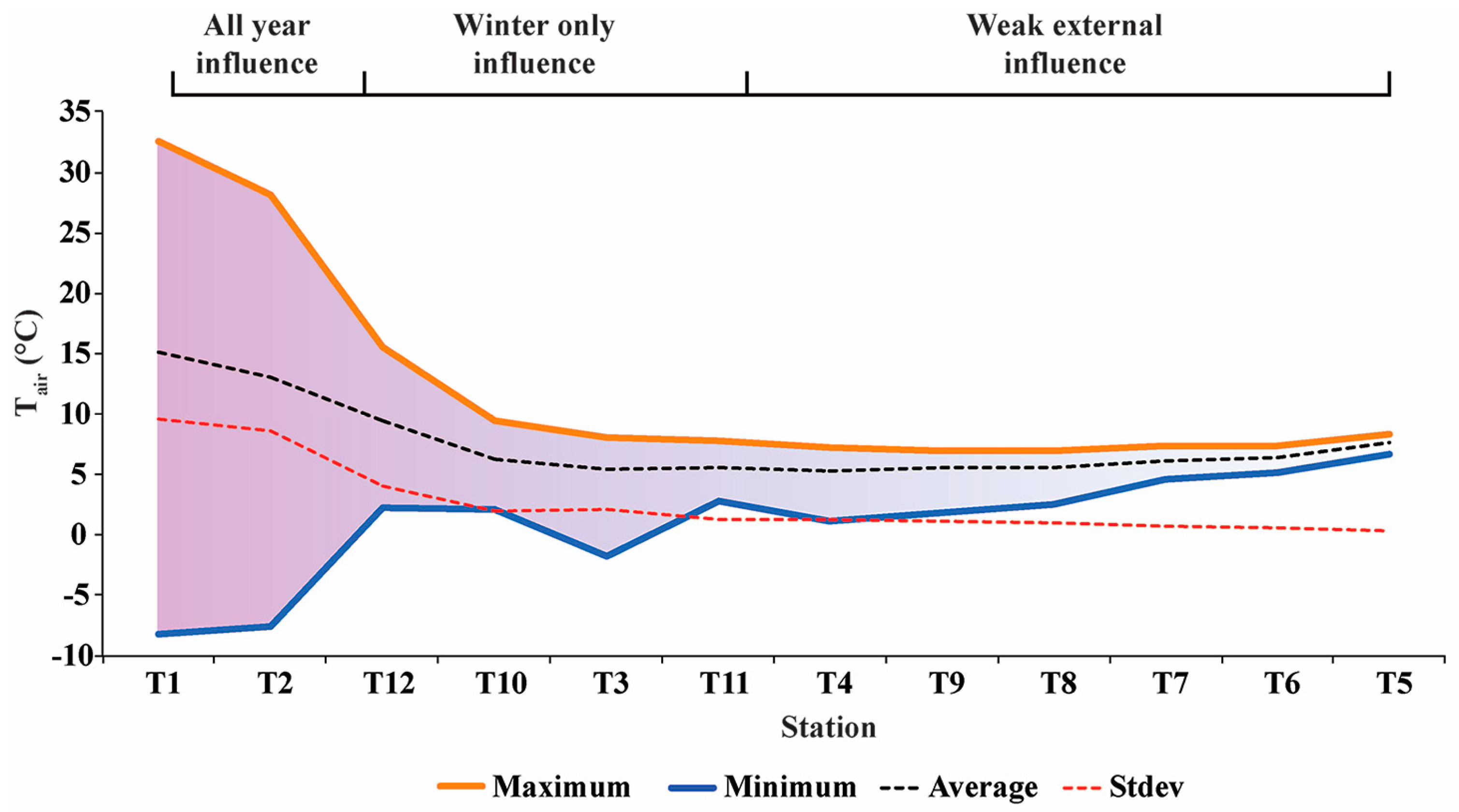
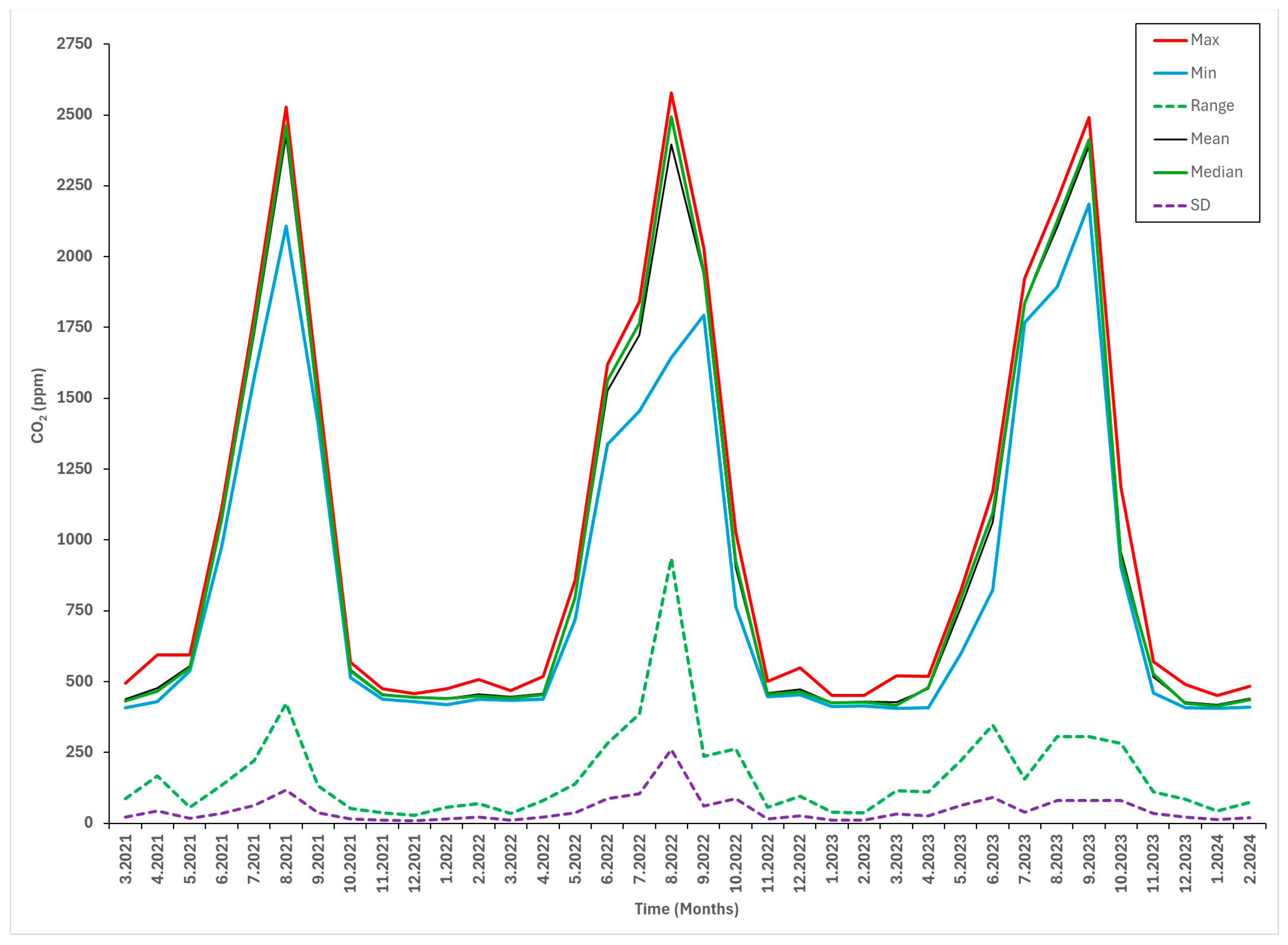


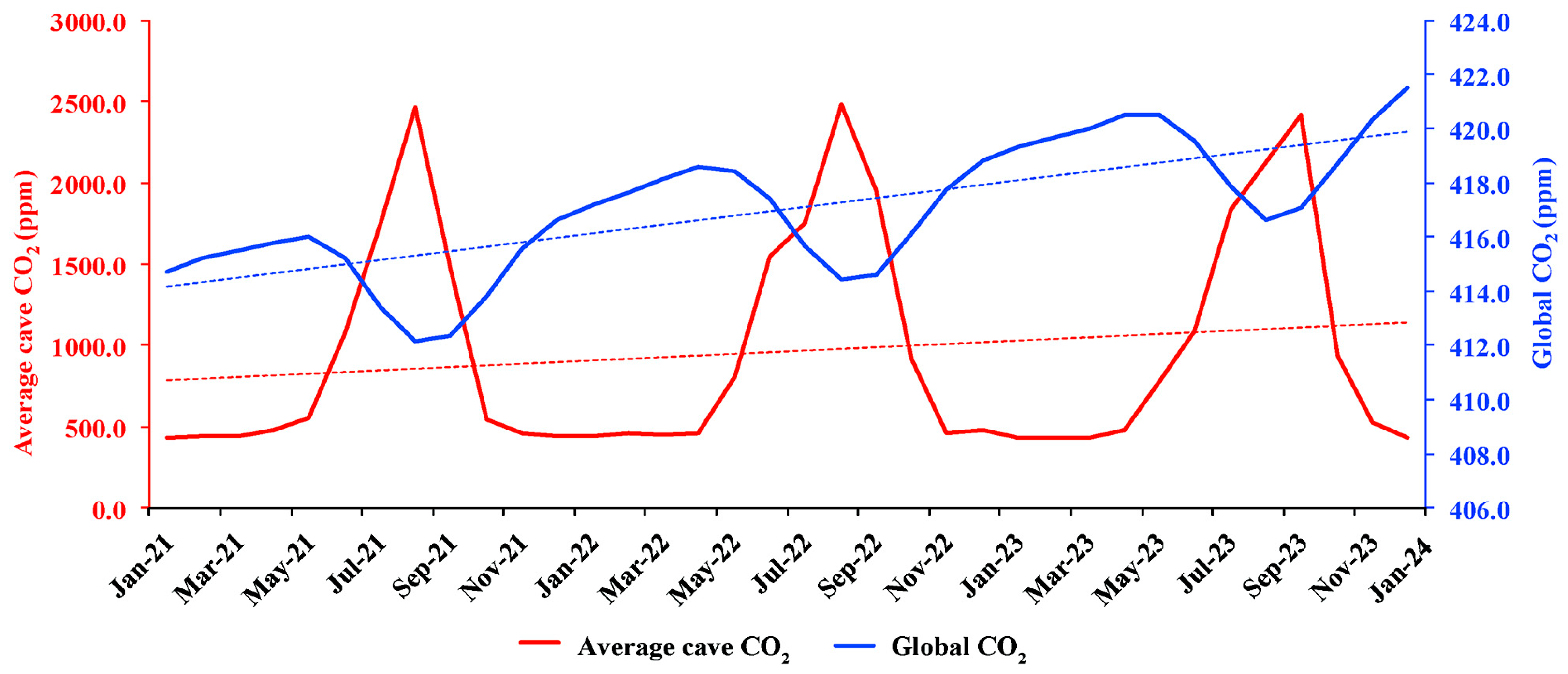
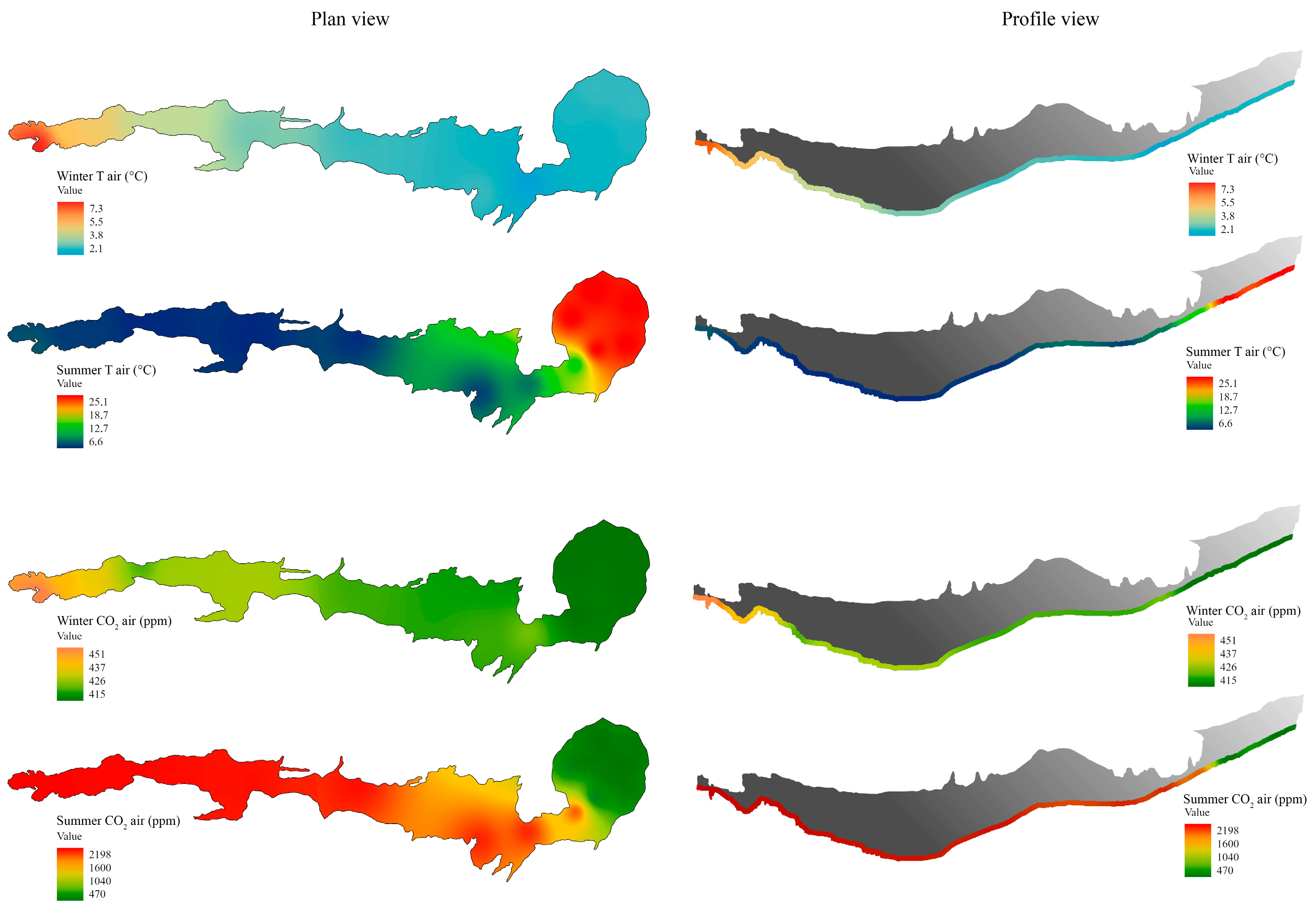

| Location | Distance (m) | Horizontal Distance (m) | Vertical Distance (m) | Note |
|---|---|---|---|---|
| T1 | - | - | - | Outside point |
| T2 | 0.0 | 0.0 | 0.0 | Collapsed doline bottom |
| T12 | 12.8 | 11.4 | 5.6 | |
| T10 | 28.3 | 25.3 | 12.8 | |
| T3 | 44.8 | 40.8 | 18.4 | |
| T11 | 87.6 | 82.9 | 28.4 | |
| T4 | 132.6 | 126.3 | 40.5 | Lowest point in the cave |
| T9 | 159.7 | 156.4 | 32.5 | |
| T8 | 170.6 | 168.6 | 26.2 | |
| T7 | 180.6 | 179.8 | 17.3 | |
| T6 | 187.0 | 185.7 | 21.7 | |
| T5 | 202.9 | 202.5 | 12.6 |
| CO2 (ppm) | Tair (°C) | |
|---|---|---|
| Max CV | 71.4297 | 44.8979 |
| Min CV | 67.1504 | 4.0119 |
| Range CV | 4.2792 | 40.8860 |
Disclaimer/Publisher’s Note: The statements, opinions and data contained in all publications are solely those of the individual author(s) and contributor(s) and not of MDPI and/or the editor(s). MDPI and/or the editor(s) disclaim responsibility for any injury to people or property resulting from any ideas, methods, instructions or products referred to in the content. |
© 2024 by the authors. Licensee MDPI, Basel, Switzerland. This article is an open access article distributed under the terms and conditions of the Creative Commons Attribution (CC BY) license (https://creativecommons.org/licenses/by/4.0/).
Share and Cite
Buzjak, N.; Gabrovšek, F.; Perșoiu, A.; Pennos, C.; Paar, D.; Bočić, N. CO2 Emission from Caves by Temperature-Driven Air Circulation—Insights from Samograd Cave, Croatia. Climate 2024, 12, 199. https://doi.org/10.3390/cli12120199
Buzjak N, Gabrovšek F, Perșoiu A, Pennos C, Paar D, Bočić N. CO2 Emission from Caves by Temperature-Driven Air Circulation—Insights from Samograd Cave, Croatia. Climate. 2024; 12(12):199. https://doi.org/10.3390/cli12120199
Chicago/Turabian StyleBuzjak, Nenad, Franci Gabrovšek, Aurel Perșoiu, Christos Pennos, Dalibor Paar, and Neven Bočić. 2024. "CO2 Emission from Caves by Temperature-Driven Air Circulation—Insights from Samograd Cave, Croatia" Climate 12, no. 12: 199. https://doi.org/10.3390/cli12120199
APA StyleBuzjak, N., Gabrovšek, F., Perșoiu, A., Pennos, C., Paar, D., & Bočić, N. (2024). CO2 Emission from Caves by Temperature-Driven Air Circulation—Insights from Samograd Cave, Croatia. Climate, 12(12), 199. https://doi.org/10.3390/cli12120199






